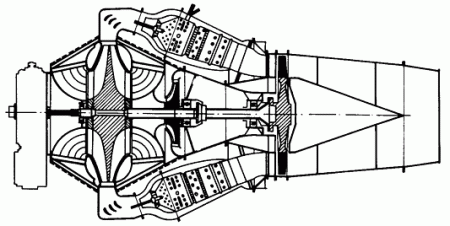The engine WK-1, which arrived in particular as drive of the MiG-17 in addition, other airplanes of the USSR of the 50’s at fame, has an interesting history.
In the years 1946/47 by the USSR the two radial engine was bought Rolls-Royces “Derwent” (30 pieces) with 16 kN to thrust and “Nene” (25 pieces) with 22 kN thrust. At the same time the reproduction of the “Derwent” was taken up under the designation RD-500 as well as the reproduction of the “Nene” under the designation RD-45. For the preparation of series production had responsibility the design engineering department Klimow, which up to then among other things the 12-Zylinder-Reihenmotoren WK-105 (772 KW); WK-105PF (912 KW); WK-107 (1214 KW) and WK-108 (1361 KW) for the fighters of Yakovlev and the bomber Pe-2 had developed.
The purchase of the radial engines was in particular meaningful under the conditions of the transition from piston motor to jet aircraft. Radial engines are characterised by a simpler construction, a higher working reliability and simple maintenance. In particular against foreign bodies they are substantially more insensitive than engines with axial compressor. Is unfavorable you concept-causes limited development potential, since multi-level radial compressors and thus high combustion chamber pressures are not realizable. Since in the USSR during the war in principle on jet engines one did not work and the German hiving rubbing works were all axial engines, one was very much interested in the assumption of British know-how in the radial engines.
The RD-45 served among other things as drive for the MiG-15 and the Il-28. Also the modifications RD-45 A and RD-45 COMPANY as well as RD-45 F were used.
Starting from 1949 from Klimow by internal re-design developed and higher performance engine stood the WK-1 ready. It carried now kN thrust for 27 out. It was used first into the MiG-15 to. In the execution it served WK-1A the MiG-17 and the IL-28 for the driveIn 1949 engine BK-1 and passed state tests in the Soviet Union became the first krupnoseriynym turbo-jets engine.
The first domestic jet engine has been created at the end of the Great Patriotic War. The first domestic jet engine has been created at the end of the Great Patriotic War.
From 1946 on the basis of accumulated scientific and technical momentum and advanced development partnership led in the years Vladimir Isaakovichem Polikovskim, led to immediate re domestic aviation fundamentally new type of jet-engine piston replacement. The powerful engine, which was named VK-1. In the years 1946-47 in OKB VJ Klimova was undertaken based on RD-45 more powerful engine, which was named VK-1. By design VC-1 is similar to RD-45: TRD with in one single bilateral centrifugal compressor, nine individual tube combustion chamber and single turbines. By design VC-1 is similar to RD-45: TRD with in one single bilateral centrifugal compressor, nine individual tube combustion chamber and single turbines.
VC-1 and VC-1 modification A traction 2700 kgs set at serial aircraft MiG-15 bis, MiG-17, VC-1 and VC-1 modification A traction 2700 kgs set at serial aircraft MiG-15 bis, MiG-17,
Il-28, Tu-14 T, as well as a large number of experienced aircraft all AeroSvit OKB USSR. Il-28, Tu-14 T, as well as a large number of experienced aircraft all AeroSvit OKB USSR. Se MiG-17 fighter aircraft with an engine BK-1 was the first domestic aircraft have overcome the speed of sound in the horizontal flight. Se MiG-17 fighter aircraft with an engine BK-1 was the first domestic aircraft have overcome the speed of sound in the horizontal flight



Leave a comment